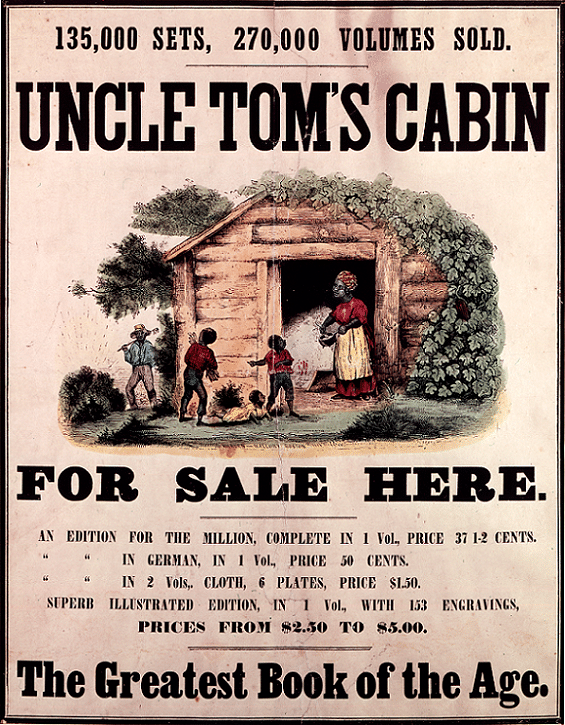Background
Abolitionist Harriet Beecher Stowe began to write the story that would become Uncle Tom’s Cabin in 1850. She wanted to highlight the trauma and tragedy of slavery in response to the passage of the Fugitive Slave Act. She based her novel on the stories of people who had escaped slavery, whom she met while working to support the Underground Railroad.
Uncle Tom’s Cabin was first published chapter by chapter in The National Era, a weekly anti-slavery newspaper. The National Era had a small audience, but word of the riveting new story spread quickly. Fans shared copies of the newspaper with their families and friends. The story became so popular that it was collected and republished as a book in 1852.
About the Image
The book version of Uncle Tom’s Cabin was an instant bestseller. This advertisement, made for booksellers to post in their shop windows around the year 1852, shows how many copies were sold in just a few months. The surge in popularity drew the attention of pro-slavery activists, who wrote scathing reviews of the novel, calling it criminal and insulting. Some critics wrote their own pro-slavery novels in response.
The criticism did not slow the sales of Uncle Tom’s Cabin. By 1857, it had sold 500,000 copies and was being called “the first real success in bookmaking.” Most importantly, the book accomplished what Harriet Beecher Stowe set out to do in 1850: it brought the abolitionist message to a wider audience than ever before.
Vocabulary
- abolitionist: A person or group that wanted to end the practice of slavery.
- engravings: Illustrations.
- Fugitive Slave Act of 1850: A law that required all people in the United States to report fugitive slaves and assist in returning them to their enslavers.
- plates: Illustrations.
- slanderous: False.
- volumes: Copies.
Discussion Questions
- What does this advertisement reveal about the early popularity of Uncle Tom’s Cabin?
- Why is the book available in German?
- The poster describes Uncle Tom’s Cabin as “the greatest book of the age.” Do you agree with this statement? Why or why not?
Suggested Activities
- APUSH Connections:
- 4.11 An Age of Reform
- 5.5 Sectional Conflict: Regional Differences
- Use this document to supplement any lesson on Uncle Tom’s Cabin to help students better understand the immediate impact the book had on American society.
- Teach this document together with the resources: Pro- and Anti-Slavery Literature for Children, Bleeding Kansas, and Life Story: Sarah Moore Grimké and Angelina Grimké Weld for a larger lesson about women writers in the abolitionist movement.
- Ask students to compare and contrast Uncle Tom’s Cabin with Harriet Jacobs’s Incidents in the Life of a Slave Girl. How do these narratives differ? What makes them powerful? What are their limitations? Which do you think should be studied to understand the experiences of enslaved women in the antebellum period?
- Literature has long been one of the limited ways women could safely express their opinions publicly. For more examples of published women activists, explore any of the following: Mourning Poetry of Anne Bradstreet, A Nun Challenges the Patriarchy, Eighteenth Century Education, A Call to Arms, Abolition and Revolution, Reflections from the Home Front, Sentiments of an American Woman, The Edenton Tea Party, Pro- and Anti-Slavery Literature for Children, Incidents in the Life of a Slave Girl, Bleeding Kansas, and Life Story: Sarah Moore Grimké and Angelina Grimké Weld.
Themes
ACTIVISM AND SOCIAL CHANGE; AMERICAN CULTURE







